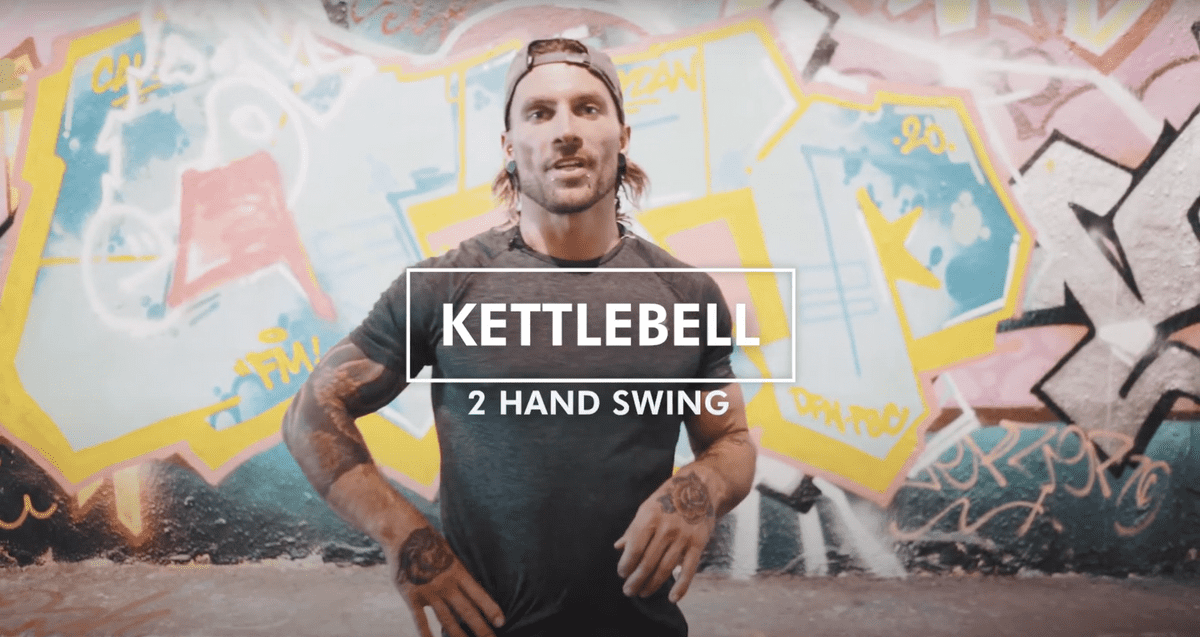Kettlebell 2 Hand Swing
by Sam Franklin
How to Master The Kettlebell Swing: The Fullbody Fat Burner
The kettlebell swing is one of the most essential of all kettlebell exercises, working almost every muscle group in the body.
While the swing offers a wealth of body-boosting benefits, getting it right is essential if you want to make real gains and avoid injury.
To help you understand the kettlebell swing and perform it the right way, here’s a practical guide to this most dynamic of exercises.
Let’s get started.
How to do a kettlebell swing: video tutorial
Before we dive into the benefits of kettlebell swing, watch our quick tutorial video by Luke Baden, Kettlebell Master Trainer.
Luke will take you step by step through the entire movement, ensuring your form is correct and you get the absolute maximum out of the exercise.
Step by Step Guide to the Kettlebell 2 Hand Swing
Step 1: The Kettlebell 2 Hand Swing
To start, approach the bell and put your toes against the bell, feet together.
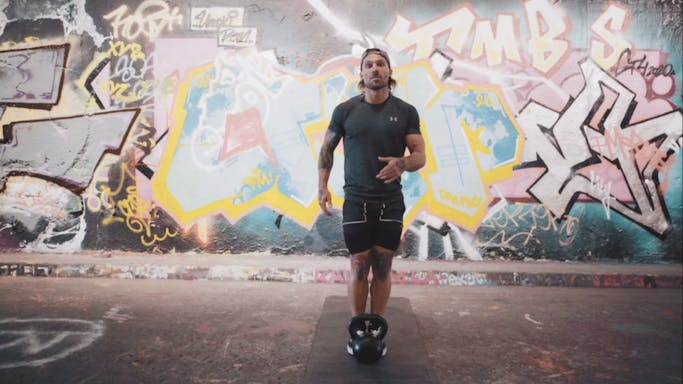
Step 2: The Kettlebell 2 Hand Swing
Turn 1 foot by 90 degrees, toes pointing away from the body, then turn back to straight. Repeat with the other foot. You should now be standing shoulder width apart just behind the bell.
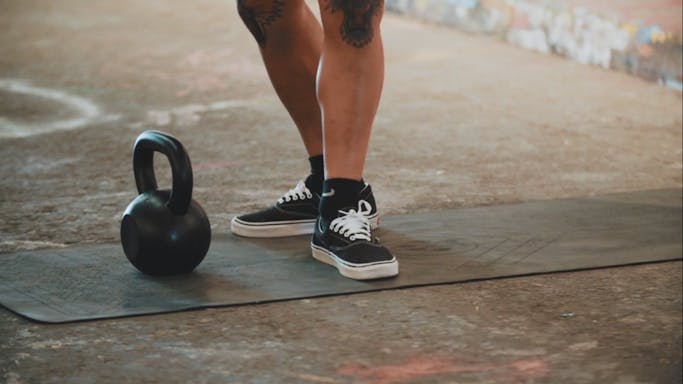
Step 3: The Kettlebell 2 Hand Swing
Push the little fingers into the hip creases to chop and drop the hips and find the hip hinge position. Find the sensation in the hamstrings.
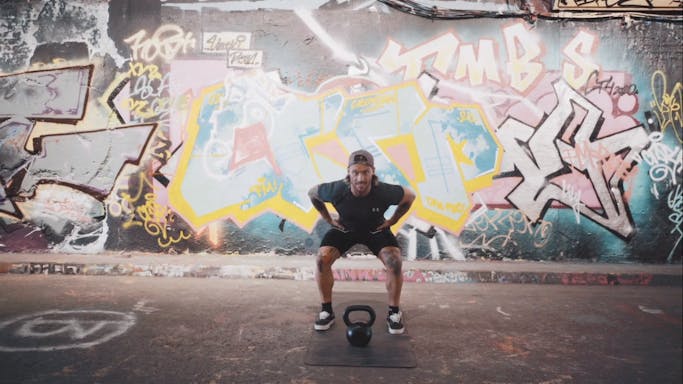
Step 4: The Kettlebell 2 Hand Swing
Put both hands on the bell and tilt the bell towards you so that it forms a projection of the arms. Squeeze the should blades back and down, flattening the armpits to the body.
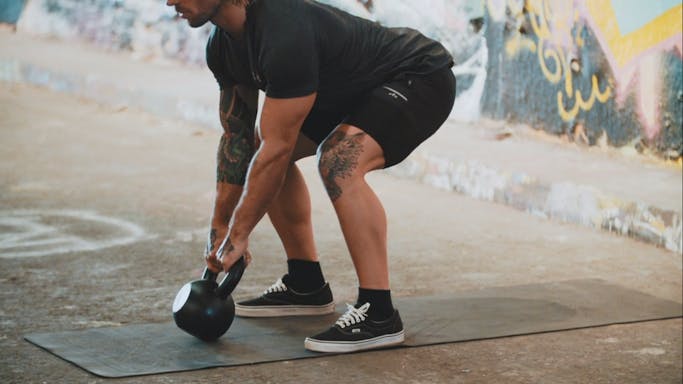
Step 5: The Kettlebell 2 Hand Swing
Lift the kettlebell and swing it back through the legs. This is the Hike Pass. Stay in the squat position.

Step 6: The Kettlebell 2 Hand Swing
Drive up and stand tall, big hip drive. Swinging the kettlebell up in front of you, let it float momentarily at the top position. Squeeze the glutes and the quads and hold the abs tight. Every rep stand tall and don't lean back.

Step 7: The Kettlebell 2 Hand Swing
Swing the kettlebell back down between the legs. The kettlebell should travel above the knee line and make sure you get the forearms back to the body before going for another rep.

The body-boosting benefits of kettlebell swings
As kettlebell swings consist of big sweeping movements, they are effective for strengthening the core. Kettlebell swings are also good for:
- Cardio: Kettlebell swings require consistent full-body movement, raising the heart rate and providing a fitness-boosting, fat-burning cardiovascular workout.
- Strength training: As kettlebell swing targets the core, hamstrings, quads, glutes, back, delts, and arms, they are one of the best and most accessible exercises for strength training.
- Balance, posture & flexibility: The classic swing is proven to improve overall balance, posture, and flexibility. Fortifying the core while conditioning the joints, and encouraging good posture, working the kettlebell swing into your workout is a wise move.
What muscle groups do the kettlebell swing work?
An excellent full-body allrounder, the kettlebell swing works a series of essential muscle groups, including:
- Hips and pelvis: An integral part of your body’s core.
- Glutes: The buttock area muscles that if strengthened, will make you more body more agile and stable.
- Hamstrings: Leg muscles responsible for aiding lower body resilience, flexibility, and knee strength.
- Deltoids: Essential for shoulder strength and upper-body injury prevention, keeping your deltoids in shape should always be a pivotal part of your workout regime.
Kettlebell swing form tips
What to do
Now that you know the body-boosting benefits of the classic kettlebell swing, let’s look at some tips to help improve your form and squeeze every last drop of value from your kettlebell workouts.
- Head positioning: Always aim to look straight ahead and avoid positioning your head downwards as this will cause you to hunch, reducing the positive impact of your swings while increasing your risk of injury.
- Foot positioning: For optimum kettlebell swing form, you should place your feet a little more than shoulder-width apart, and point your toes forwards. Make sure that you feel comfortable in your position to ensure you’re able to perform a safe, fluid movement.
- Back posture: Make sure that your back is nice and straight—correct any slouching before performing your kettlebell swings.
- Placement: Lower the kettlebell between your legs and pop your hips forward. When performing a swing, using your legs and hips y to raise the kettlebell swiftly is essential, so you should always aim to place or pop your hips into a forward positing.
- Swing height: If you’ve followed all of the advice above, you will be ready to start swinging. Flex your knees slightly and gently pull the kettlebell between your legs to gain momentum, swinging it with straight arms to chest level so that your arms are parallel with the floor—swing back down fluidly, and repeat.
- Choose the right kettlebell size: You should always choose your kettlebell weight based on your size, strength, and level of fitness. If you’re starting out, a 12kg kettlebell may be the most suitable, but if you have some strength training experience, a 16kg or 20kg option will prove more effective.
Things to avoid
When it comes to kettlebell swings, knowing what to avoid will help you prevent any nasty injuries. So, for a successful full-body kettlebell workout:
- Don’t go too big too quick. Start with a more modest kettlebell weight and smaller sets, increasing the quantity and intensity over time.
- Don’t flick the kettlebell with your wrists during each end of your swing—make sure you keep them straight at all times.
- Don’t push or pull directly from your back as you could injure yourself (or at the very least, make your workout less effective)—remember, it’s all in the hips.
- Don’t be complacent when picking up or putting down the kettlebell. Always bend your knees and keep your back straight.
Related kettlebell swing exercises
Finally, if you want to maximise your kettlebell swing workout, here are some related exercises you should explore:
Kettlebell 2 Hand Swing video transcript
This is the tutorial video for the kettlebell 2 hand swing.
So, how it’s going to go down is: You’re going to approach the bell, putting tiptoes on bell, here, twisting one foot out to 90 degrees and back, same thing on the other side.
From there, little fingers, chopped and dropped into the hips to find your hip hinge position. Find the sensation in the hamstrings.
Tilt kettlebell over so that it forms a projection of the arms. Squeeze shoulder blades back and down. Flatten armpits to the body.
We’re going hike pass, then we’re driving up, standing tall. Big hip drive. Squeeze quads, squeeze glutes and hold abs tight. Let the kettlebell float momentarily at the top position.
Every rep standing tall, don’t lean back. Upper body remains passive, just the hands holding on the bell.
On the way back down, the kettlebell should travel above the knee line, it shouldn’t come down here. When you get the forearms back to the body, then go into this position for another rep.
That was the tutorial video for the kettlebell 2 hand swing.
